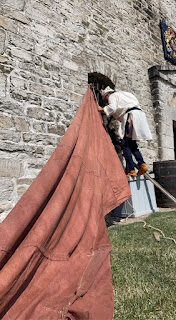I was very fortunate to participate in four Seven Years War in America re-enactments this summer. Fort de La Présentation in Ogensburg NY, Fort Niagara in Youngstown NY and Fort Carllion In Ticonderoga NY, and Fort St. Frederic in Crown Point NY.
I’ll say the first thing I need to do is figure out how people in the 18th century dealt with bugs! I had a problem with mosquitos in Carllion and a problem with biting ants at Fort St. Frederic. If these senarios were real life moving to a more advantageous place would have been the reality. I didn’t have much choice when I was in either of those places. So I learned that I need to find out how 18th century people dealt with bugs. I must admit I resorted to modern means in order to quell the onslaught.
The second thing I learned is the importance of shade. At fort Niagara wanting to be as historically correct as possible, traveling very light, and because I had access to an entire stone building I didn’t bring tent poles, just my prélart and some ropes and wooden tent pegs. The building was hotter inside than outside because of poor to no ventilation. The outside was stifling because of a lack of shade.Attempts to suspend the tarp from the bars on the building’s windows and holding edges down with wooden stakes proved futile. The wind at that fort is quite stiff and whips violently across the totally open bowl shaped grounds of the fort. Not being able to stand broiling in the sun any longer I vowed to never go without shade again and cut poles and ropes to suspend my prélart from when I returned home.
At Carllion we had the pleasure of cutting poles. I went with a breezy lean to made of sticks lashed together in a rough grid. It’s real purpose was the provide shade which it did well during the event. Luckily we were encamped near the woods and when things got really sunny we could retreat to she shade of some trees. I also had the privilege of using plenty of rope and iron tent stakes. Had I needed to it could have been done without them but was much easier doing with them.
At Fort St. Frederic I brought six poles, 8 ropes and 10 iron tent stakes. This provided me with a spacious breezy lean to with an over hang. It was fantastic to sit under and smoke my pipe while at the fort. My fellow milice and I had to chase the shade a bit but we were gifted a watermelon by “The Wolves of the English”,our native British allied enemies for the weekend, and I personally stayed quite refreshed.
The poles are unfortunately a necessary evil in our times. Except for those few events in my home county or where I can cut poles, I can’t in good conscience transport wood which may spread disease or parasites to other woodlands.
The iron tent stakes are a modern luxury. I would never in a million years cart around that heavy canvas prélart and a bag of iron tent stakes. I simply wouldn’t do it. Cutting wooden tent stakes and a maul to pound them into the ground with is my next big project. My last foray into wooden tent stake making only really made kindling.
I learned that the resources of time and natural space was much more plentiful in the 18th century. I’m at a site for a long weekend or sometimes just one day and an overnight. Even if every historic site allowed me to cut poles and erect shelters at every place in the woods I wouldn’t have enough time for demonstrations and battle reenactment scenarios and things like earrings and socializing. If I don’t erect some sort of shaded cover my health will suffer and I won’t participate in the event fully anyway.
For the moment I’ll count the iron tent stakes as a modern luxury in need of correction. The poles (and potentially the rope) are questions of place, resources and time. Do I have the resources and time in the place I am in to cut poles and produce cordage? Usually the answer is no.








No comments:
Post a Comment